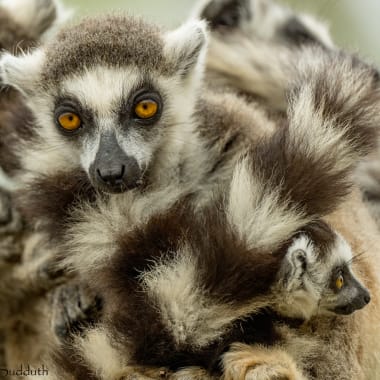
Ngorongoro Crater
Ngorongoro Crater: an impressive natural wonder
Ngorongoro Crater: an impressive natural wonder
Formed millions of years ago: The Ngorongoro Crater on the edge of the Serengeti is a place of longing for safari travelers. The landscape ranges from densely forested highlands to a steppe-like volcanic basin.
As a cave-in crater with a spectacular density of big game, the Ngorongoro Conservation Area is one of Africa's top destinations. As part of the Serengeti, the crater has had national park status since 1951. Awards as a UNESCO World Natural and World Cultural Heritage Site followed. Would you like to find out more about this special place where the Maasai live side by side with around 25,000 wild animals?
Scientific findings indicate that the Ngorongoro Crater was as impressive as Kilimanjaro. Even today, the crater rims of the former six-thousander reach up to an altitude of 2,000 meters. It can get particularly chilly at night in the cloud forests of the high mountains. One more reason why sleep in the safari lodges built here is so restful.
Even the journey to the crater through the rainforest is an experience in itself. The vast caldera with its natural boundaries opens up like a paradisiacal garden. No wonder it is still possible to spot the rare black rhino in the Ngorongoro Crater. With a bit of luck, you will see the big five in a single day.
Best time to travel
The best time to visit the Serengeti is between July and October.
Wildlife in the Ngorongoro Crater
No other place on the African continent has as many predators as the Ngorongoro Crater. With buffalo, wildebeest, zebra and antelope, the typical prey of lions and leopards can also be found here in large numbers. Year after year, huge herds of ungulates pass through the region in search of fresh greenery and water. The great migration is by no means the only attraction. Elephants, giraffes, exotic birds, hyenas, gazelles and many other animal species can be seen in the reserve all year round.
With their bright plumage, the pink flamingos stand out impressively against the shimmering white waters of Lake Magadi. You can also observe hippos here as they take a long swim. Tanzania's wildlife is rich in species and diverse and is concentrated in the Ngorongoro Crater. The best conditions for successful safari tours with enviable photo stops. Would you like to finally experience the Big Five - elephant, lion, leopard, rhino and buffalo - live? The chances are also ideal!
Activities in the Ngorongoro Crater
Many exciting activities await you in the Ngorongoro region. Our tip: Discover the sights off the beaten track, such as the Olduvai Gorge. You can also visit the graves of the German animal filmmakers and zoologists Michael and Bernhard Grzimek here.
In der Ngorongoro Region erwarten Sie viele spannende Aktivitäten. Unser Tipp: Entdecken Sie auch die Sehenswürdigkeiten abseits klassischer Safarirouten wie die Olduvai-Schlucht. Die Gräber der deutschen Tierfilmer und Zoologen Michael und Bernhard Grzimek können Sie hier ebenfalls besuchen.
Game drives
On board an off-road vehicle, you go on a discovery tour with knowledgeable guides. You can rely on the experience of the safari experts. They know the area like the back of their hand and will guide you to the best spots for impressive wildlife sightings. Just like the rest of the Serengeti National Park, the area of the Ngorongoro Crater is not fenced in. The animals can move around freely.

Hiking
Would you like to actively explore nature? There are rewarding excursion destinations for hikes and mountain bike tours around the Ngorongoro Crater. You can visit other small volcanic craters such as Empakaai, which is around 40 kilometers away. There are particularly idyllic routes along the banana and coffee plantations of Lake Manyara. The paths on the flat terrain are suitable for adventurers of all ages.
For history buffs, the Olduvai Gorge is well worth a visit. The gorge, which is around 50 kilometers long and up to 90 kilometers deep, is considered the cradle of mankind. European researchers have found traces of pre-human settlement here. The archaeological excavations have not yet been completed. You can marvel at important exhibits in the small museum.

Visiting the Maasai
As semi-nomads, the Maasai move through the grass steppe of the crater landscape with their herds of cattle. How they live in harmony with nature and the wild animals is one of the most fascinating travel experiences. Authentic, warm and approachable, the locals talk about the peculiarities and challenges of their everyday lives. We bet you will never forget your visit to a traditional Maasai village.

The best time to visit the Ngorongoro Crater
Due to the geographical differences in a compact area, the climate in the Ngorongoro Crater is subject to natural fluctuations. The best time to visit is the dry season from June to September. Temperatures are pleasant then and visibility inside the crater is clear. Nevertheless, it can cool down considerably at night, especially in the high mountains, so warm clothing should not be missing from your luggage.
During the rainy season between March and May, the paths can be muddy and difficult to navigate. At the same time, the crater landscape is in full bloom.
Safaris in Ngorongoro Crater
Lodges in Ngorongoro Crater
To book a trip or for more information, contact us. We'll help you plan and guide you through your upcoming adventure!






